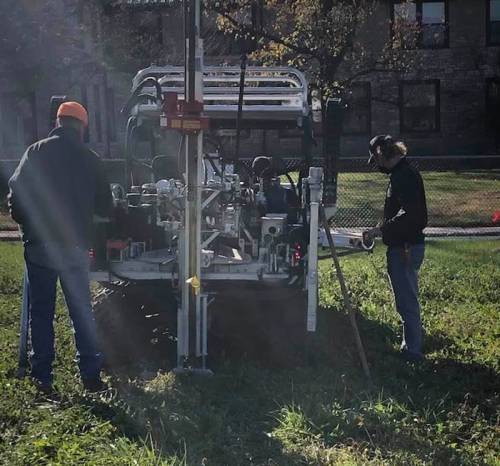Nearly 30 years after it was established in 1888, researchers at the University of Missouri began the process of taking and studying soil cores at Sanborn Field. About every 25 years, those cores are taken again to gain an understanding of the changes in the soil over time, given the variety of treatments and rotations that occur each year.
It’s been more than 30 years since the soil cores have last been studied. Tim Reinbott, director of Sanborn Field, worked throughout 2020 to secure funding and was able to put together a team of partners who removed the cores in November 2020.
“Long-term research of this nature is really important, as it gives us some really good insights into soil changes over an extended period of time,” said Reinbott, who is also the assistant director of the University of Missouri College of Agriculture, Food and Natural Resources (CAFNR) Agricultural Experiment Station. “Sanborn Field is so historic, and I’m happy to be able to continue this research.”
Along with the traditional soil analysis that has happened about every 25 years since 1915, Reinbott added that they plan to do something new with the cores removed in 2020 – they will run a soil health analysis.

“Traditionally, we take cores from each plot at Sanborn Field, with a total of 162 cores throughout the entire field,” Reinbott said. “This year, we doubled the amount of cores, giving us 324, with half of them being used for our usual analysis and half being used for health analysis.”
Probes went down four feet to extract each core. The cores are taken from the center of the plots at locations that were specifically identified in 1963 – and extra cores from the edge of the plots are used to refill the original plots.
“We do all of the measurements from the interior of the plots,” Reinbott said. “We refill those plots because we can’t have a bunch of holes in the middle of our plots that could change the water hydraulics.”
The soil cores for the traditional analysis are currently at the Soil and Plant Testing Laboratory, led by Manjula Nathan, Extension associate professor in the Division of Plant Sciences. The cores for the soil health analysis are with the Soil Health Assessment Center. Stephen Anderson, William A. Albrecht Distinguished Professor of Soil and Environmental Sciences, and adjunct professor in the Division of Plant Sciences, serves as the interim director of the center.
“I’m really excited to see what our results show, especially on the soil health side,” Reinbott said. “Having brand new information and data is great, considering Sanborn has been around for more than 130 years.”
Reinbott said they are freezing samples as well, for future use.
“I’m sure there are some measurements that we don’t even know about,” Reinbott said. “That’s why we decided to freeze some samples for future analysis. If there are some measurements that we learn about at a later date, we can use these frozen samples.”

Support for the project came from the MU School of Natural Resources (SNR), the United States Department of Agriculture (USDA) Natural Resources Conservation Service (NRCS) and the USDA Agricultural Research Service (ARS). Along with financial support, the entities played an important role in the extraction process.
“Taking the cores took weeks in the past, and with all of the help, we were able to complete everything in just three days,” Reinbott said. “We were really fortunate to have so much great expertise throughout the week.”
Having such a big pool of partners also led to excellent learning opportunities for students. Several CAFNR professors brought their classes out to be a part of the extraction process. Numerous students also volunteered to help during the week.
“There were so many great teaching moments throughout the week,” Reinbott said. “Since we go four feet deep, you get a great look at the soil horizons. You can learn so much from studying those horizons, and our students benefitted from getting to dive deeper into viewing those cores.”
The soil cores also showed very subtle soil erosion that has occurred over the past 30 years.
“By knowing that we are seeing soil erosion, we can actually see the productivity of the soil starting to decrease,” Reinbott said. “Even though our yields are increasing, due to better genetics over the years, we are really robbing ourselves of better yields because of the degradation of the soil. That degradation not only results in loss of crop yield, it has a negative environmental impact.”
Reinbott said he is hoping to host a symposium at a later date to discuss the results and what the data indicates.
“This is just the tip of the iceberg for a lot more analysis than we’ve ever had before,” he said. “I can’t wait to start putting the data together and see what we get. Sanborn Field has always changed to the most modern practices. Maybe it’s time to draw that line and update what we’re doing. That’s a much bigger discussion, and I’m excited to jump in to it.”